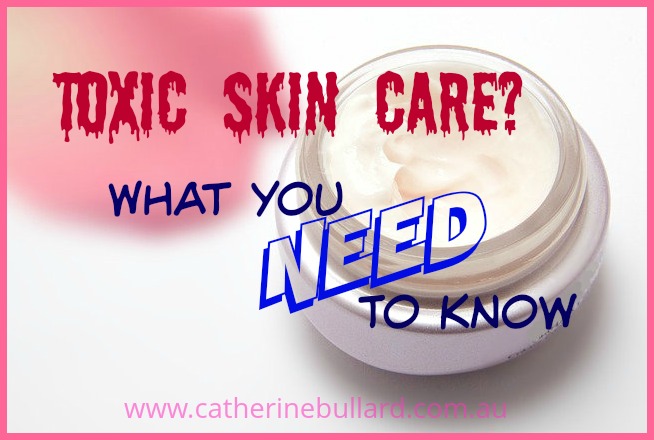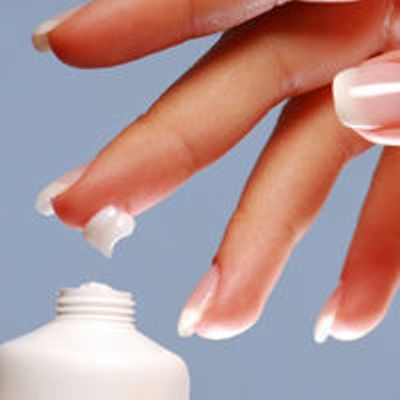It’s astonishing that most high end skin and hair care products contain so many super-toxic ingredients. Especially since they all claim extraordinary nourishing and rejuvenating benefits. Incredibly the toxic chemicals they contain often actually cause the dehydration, dermatitis or aging skin problems they claim to prevent. It’s essential to know your ingredients if you truly want to care, preserve and nurture the quality of your skin. You need to know which toxic skin care ingredients to avoid.

Being a conscious shopper is difficult when Australian legislation doesn’t support consumer health. With long, unpronounceable names you may find it impossible to know which toxic chemicals to avoid. Even if you do know which are harmful, the micro-script printing of ingredients renders them unreadable. In fact they’re often not even listed on the product at all. Legislation only requires the ingredients be displayed at the point of sale, not necessarily on the product.
And we’re human! We’re easily seduced by pretty smells, creamy texture, luxury packaging in our favourite colour, outrageous claims, prestige brands, or simply brand loyalty.
But knowledge is power! Here are a few things it’s really worth you knowing before we examine toxic skin care ingredients in detail.
Organic Skin Care Claims
Legislation governing the claim that a product’s organic is loose. Legally any product containing carbon, found in all plant and animal matter, can be called organic. Luckily only products containing organically grown ingredients are generally labelled organic.
 However, all the ingredients don’t need to be organic. Organic ingredients may only constitute 1 or 2 percent of the total to warrant the claim of being an organic product.
However, all the ingredients don’t need to be organic. Organic ingredients may only constitute 1 or 2 percent of the total to warrant the claim of being an organic product.
Often the organic ingredient is combined with the same range of toxic chemicals found in other ‘non-organic’ products.
The answer?
Read the label before you buy. And it helps if you quickly recognize some of the worst common skin care toxins.
Companies are ‘put on trust’ to disclose the truth about their products. However they don’t have to substantiate any of their claims unless they’re challenged in court.
Could you afford the legal fees to challenge their claim that you’ll look younger when you use their product?
It rarely happens.
So What’s The Solution?
Read the label. And learn what it is you’re reading, even if you just know the most harmful chemicals to avoid.
It’s vital to remember that although there may only be small of amounts of each harmful ingredient in the product they accumulate, and they’re present in every product you’re using. You use many of these products every single day. Plus there are many other household products also containing these toxic additives. This all adds up to a significant toxic load that you’re exposed to daily. These continual small exposures add up and may result in serious disease later on in life.
What does this mean for you?
Basically when it comes to skin care product benefit claims there’s little transparency. If you want natural, beneficial products that don’t harm it rests with you. It’s up to you whether you want to settle for products just a little “cleaner” or get one that’s really top-quality health and beauty-wise.
10 Toxic Skin Care Ingredients To Avoid
So here’s the bottom line you’re waiting for, the 10 most dangerous chemicals found in skin care products.
- The first few ingredients on the label are the most important.
- All ingredients are listed by quantity. That means there’s more of the ingredients at the top of the list and much less of those at the end.
The most harmful ingredients you MUST avoid are:
PETROLEUM PRODUCTS (Mineral oil, Paraffin, Petrolatum)
These coat the skin like plastic, clogging pores and interfering with waste elimination. Toxins then build up causing acne and dermatitis. Petroleum products slow skin cell development leading to premature ageing. They’re are often used to protect against sun damage in products like lip balms. But mineral oil promotes skin photosensitivity (sun damage) and interferes with the body’s own moisturisation so they actually cause dry and chapped skin.
SYNTHETIC FRAGRANCES
Synthetic fragrance is insidious. Fragrances cause skin irritation, rash, headache, dizziness, vomiting, coughing and hyperpigmentation. They can affect the central nervous system and cause depression, hyperactivity and irritability. Because they contain up to 4000 ingredients there’s no way to know exactly what they do contain. Many of these 4,000 ingredients are toxic or carcinogenic, If you want products with a fragrance choose those containing essential oils instead.
PARABEN PRESERVATIVES (Methylparaben, Butylparaben, Ethylparaben)
Widely used and known to be highly toxic, parabens are a preservative that inhibits microbial growth and extends shelf life. They cause many allergic skin reactions and skin rashes, irritate eyes and respiratory tract, and are connected to cancer. They mimic oestrogen which disrupts the hormonal process of the endocrine system.
PROPYLENE GLYCOL
A synthetic petrochemical, propylene glycol inhibits skin cell growth, weakens cell structure, causes allergic reactions, dermatitis, skin irritation, conjunctivitis, and kidney/liver abnormalities. Included as a ‘moisturizer’, it’s also found in fragrance oils. It is toxic and dangerous. The EPA requires workers handling it to wear protective gloves, clothing and goggles and to dispose of it by burying it in the ground. In spite of this, there’s no warning label requirement for products like stick deodorants, even though the concentrations are higher than in most industrial applications.
SODIUM LAUREL/ LAURETH SULPHATE (SLS or SLES), AMMONIUM LAURYL SULPHATE (ALS)
These are the synthetic substances that build ‘foaminess’ in shampoos. They dehydrate skin and inflame and separate skin layers. They cause eye irritation, skin rashes, hair loss, scalp scurf like dandruff, and allergic reactions. SLS, SLES and ALS break down the moisture barrier in the skin. Found in over 90% of foaming personal care products including shampoos, skin care and even toothpastes, as well as engine degreasers and garage floor cleaners. Don’t be deceived into thinking it is ok if it says ‘derived from coconut’, because these become a carcinogen.
TRIETHANOLAMINE (TEA) – will often have a number added
TEA is a synthetic emulsifier which is severely irritating to dry tissues. It causes allergic reactions, eye problems, dry skin and hair, and can be toxic if absorbed over a long period of time. Over 40% of cosmetics containing TEA have been found contaminated with nitrosamines (potent carcinogens). The Material Safety Data Sheet actually advises wearing a face shield if there is danger of eye contact.
You’ll be shocked to know that this and many other of the 10 skin care toxins are found in many baby products
POLYETHYLENE GLYCOL (PEG) – sometimes with a number added
PEG reduces the skin’s natural moisture factor leaving it vulnerable to bacteria. They contribute to the signs of ageing in skin. They’re very commonly used and connected with liver and kidney damage as well as being a carcinogen. You’ll also find them in caustic spray-on oven cleaners.
STEARALKONIUM CHLORIDE:
Highly toxic, it can cause allergic reactions. Originally developed as a fabric conditioner, it’s now used in creams and hair conditioners because it’s cheaper than herbals or proteins. Over time it causes hair to become dry and brittle.
DIAZOLIDINYL UREA:
The American Academy of Dermatology rates diazolidinyl urea as the primary cause of contact dermatitis. It’s the most commonly used preservative after parabens. Diazolidinyl urea contains formaldehyde which is toxic if inhaled. It causes skin nose, eyes and throat irritation coughing and difficult breathing.
SYNTHETIC COLOURS:
Synthetic colours only make products look pretty. Avoid anything with synthetic colours added as studies show they’re cancer-causing agents which serve no beneficial purpose in the product.
Here are a few more toxins to avoid, although they’re just a few of many others.
- Toulene – (benzoic, benzyl) A well known poison affecting many organs and found in synthetic fragrances. It’s fatal if swallowed and harmful if inhaled or absorbed through the skin.
- Oxybenzone – (or benzophenone-3): Found in products offering sun protection, it inactivates the skins own antioxidant system. It leads to premature ageing, disrupts hormones, and causes cancer. Ironically, it reacts under UV light (ie: in the sun) to potentially damage DNA and affect development.
- Retinal Palmitate – decomposes under UVA rays into chemicals that cause cell mutations. It’s photo-toxic so it causes skin ageing but is often found in anti-ageing products!

Now, This Is Important
Children are at much greater risk from these toxic chemicals.
The EWC (Environmental Working Committee) recommends paying particular attention to products for children and babies which contain harmful ingredients. This is because they pose a greater risk.
Children are much smaller than adults so they’re far more exposed relatively to the dangers of the contaminants. Their organs are immature and much less capable of dealing with the assault.
It All Boils Down To This…
It isn’t just about how your skin and hair looks.
These toxins have a huge effect of your health. Many people’s health dramatically improves when they change their hair, skin, make-up and personal products to more natural, less toxic ones.
When you switch to products with natural healthy ingredients you may find that problems like allergies quickly improve. I see this all the time with my clients in clinic.
Even if all you do is to ditch products containing artificial colours or synthetic fragrances you’ll notice a difference. And it’s a simple way to begin.
Like all products, individual needs play a part in your choice of natural skin and hair products. Experiment until you find the one that suits your skin and hair the best. I tried many health natural shampoos and conditioners before I found one that suits my hair leaving it beautifully soft.
Your Anti-Shopping List
Use this list to navigate through the jungle of scientific names.
- PETROLEUM PRODUCTS: (Mineral oil, Paraffin, Petrolatum)
- SYNTHETIC FRAGRANCES
- PARABEN PRESERVATIVES (Methylparaben, Butylparaben, Ethylparaben)
- PROPYLENE GLYCOL
- SODIUM LAUREL/ LAURETH SULPHATE (SLS or SLES), AMMONIUM LAURYL SULPHATE (ALS)
- TRIETHANOLAMINE (TEA)
- STEARALKONIUM CHLORIDE
- DIAZOLIDINYL UREA
- SYNTHETIC COLOURS
- POLYETHYLENE GLYCOL (PEG)
Personal care products are supposed to enhance our skin and hair.
Make sure yours are food for your skin and not full of toxic skin care ingredients.

Disclaimer
All information and opinions presented here are for information purposes only and are not intended as a substitute for professional advice offered during a consultation with your health care provider. Do not use this article to diagnose a health condition. Speak to your doctor if you think your condition may be serious or before discontinuing any prescribed medication. Please consult with your health care provider before following any of the treatment suggested on this site, particularly if you have an ongoing health issue.


